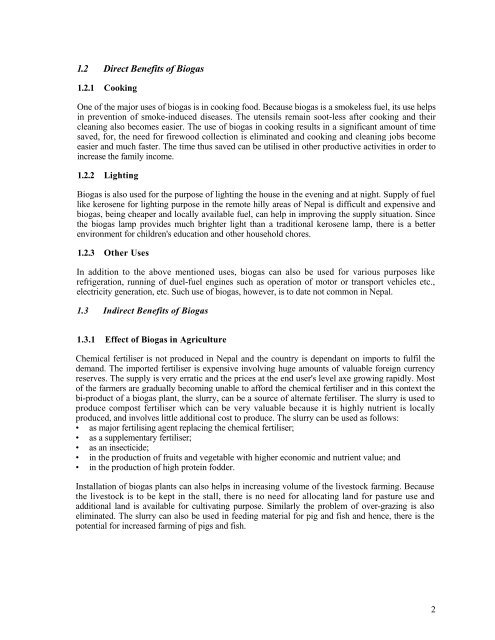Download - SNV
Download - SNV
Download - SNV
Create successful ePaper yourself
Turn your PDF publications into a flip-book with our unique Google optimized e-Paper software.
1.2 Direct Benefits of Biogas<br />
1.2.1 Cooking<br />
One of the major uses of biogas is in cooking food. Because biogas is a smokeless fuel, its use helps<br />
in prevention of smoke-induced diseases. The utensils remain soot-less after cooking and their<br />
cleaning also becomes easier. The use of biogas in cooking results in a significant amount of time<br />
saved, for, the need for firewood collection is eliminated and cooking and cleaning jobs become<br />
easier and much faster. The time thus saved can be utilised in other productive activities in order to<br />
increase the family income.<br />
1.2.2 Lighting<br />
Biogas is also used for the purpose of lighting the house in the evening and at night. Supply of fuel<br />
like kerosene for lighting purpose in the remote hilly areas of Nepal is difficult and expensive and<br />
biogas, being cheaper and locally available fuel, can help in improving the supply situation. Since<br />
the biogas lamp provides much brighter light than a traditional kerosene lamp, there is a better<br />
environment for children's education and other household chores.<br />
1.2.3 Other Uses<br />
In addition to the above mentioned uses, biogas can also be used for various purposes like<br />
refrigeration, running of duel-fuel engines such as operation of motor or transport vehicles etc.,<br />
electricity generation, etc. Such use of biogas, however, is to date not common in Nepal.<br />
1.3 Indirect Benefits of Biogas<br />
1.3.1 Effect of Biogas in Agriculture<br />
Chemical fertiliser is not produced in Nepal and the country is dependant on imports to fulfil the<br />
demand. The imported fertiliser is expensive involving huge amounts of valuable foreign currency<br />
reserves. The supply is very erratic and the prices at the end user's level axe growing rapidly. Most<br />
of the farmers are gradually becoming unable to afford the chemical fertiliser and in this context the<br />
bi-product of a biogas plant, the slurry, can be a source of alternate fertiliser. The slurry is used to<br />
produce compost fertiliser which can be very valuable because it is highly nutrient is locally<br />
produced, and involves little additional cost to produce. The slurry can be used as follows:<br />
• as major fertilising agent replacing the chemical fertiliser;<br />
• as a supplementary fertiliser;<br />
• as an insecticide;<br />
• in the production of fruits and vegetable with higher economic and nutrient value; and<br />
• in the production of high protein fodder.<br />
Installation of biogas plants can also helps in increasing volume of the livestock farming. Because<br />
the livestock is to be kept in the stall, there is no need for allocating land for pasture use and<br />
additional land is available for cultivating purpose. Similarly the problem of over-grazing is also<br />
eliminated. The slurry can also be used in feeding material for pig and fish and hence, there is the<br />
potential for increased farming of pigs and fish.<br />
2
















